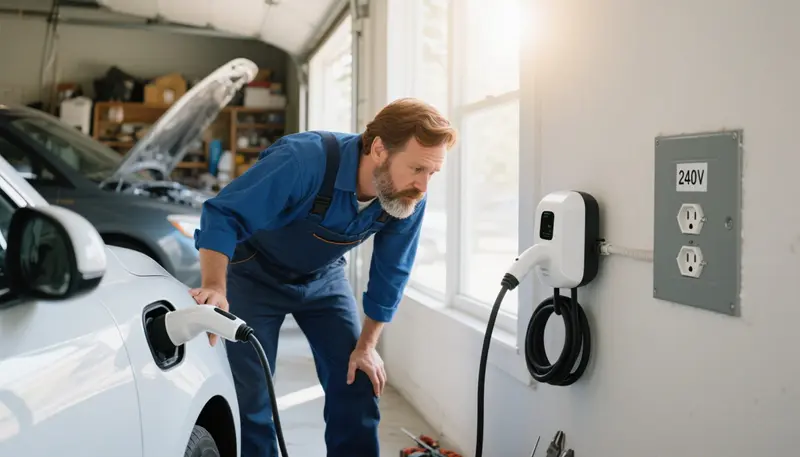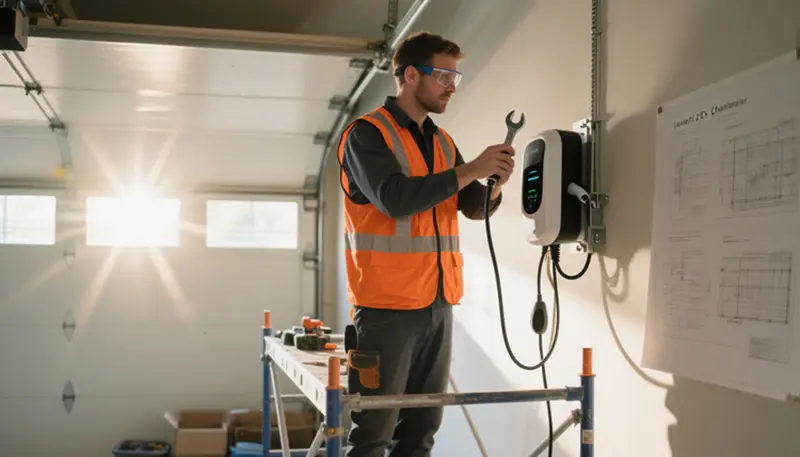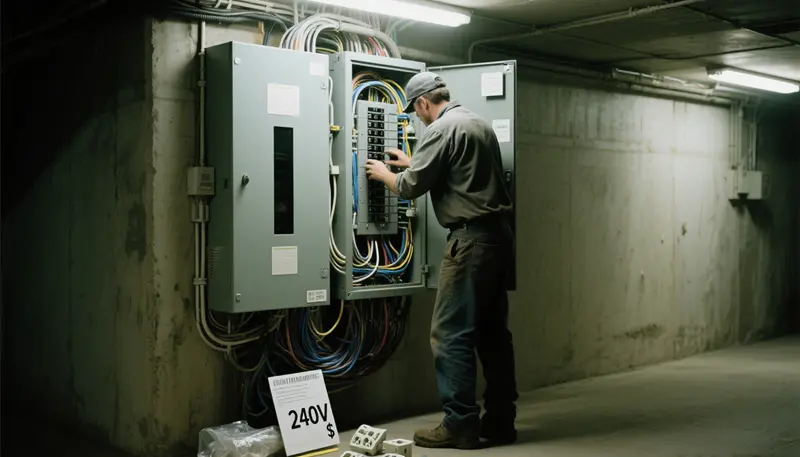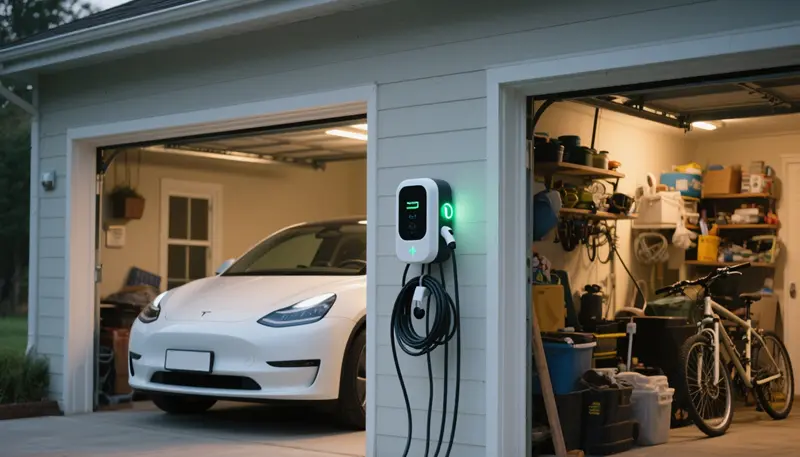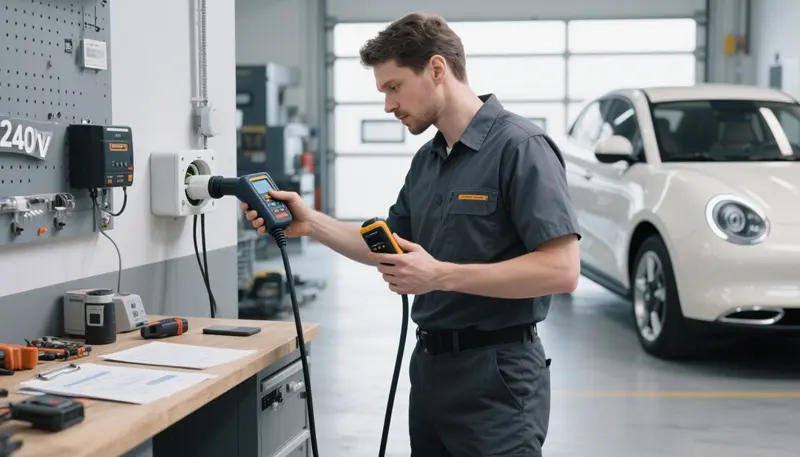Blog
Is a Level 2 Charger the Same as a 240 Volt? Key Differences Explained
Clarifying Level 2 Charger vs. 240V Outlet
As electric vehicles (EVs) gain popularity across the U.S. and Europe, homeowners are increasingly exploring home charging solutions. A common question arises: Is Level 2 charger the same as 240 volt? This confusion stems from the close relationship between Level 2 chargers and 240V electrical systems, often used interchangeably in casual conversation. However, they serve distinct roles in EV charging. This comprehensive guide addresses the core question: is a Level 2 charger the same as a 240 volt, and provides an in-depth comparison of Level 2 charger vs. 240V outlet, empowering EV owners with clear, actionable insights.
Whether you’re installing a Level 2 charger for a Tesla, Nissan Leaf, or Ford Mustang Mach-E, understanding the technical and practical differences between a Level 2 charger and a 240V outlet is crucial for a safe and efficient setup. We’ll explore their functions, installation processes, costs, and common misconceptions, ensuring you can confidently plan your home EV charging station.
What Is a Level 2 Charger?
Understanding the Role of a Level 2 Charger
A Level 2 charger is an Electric Vehicle Supply Equipment (EVSE) designed to charge EVs using a 240V or 208V alternating current (AC) electrical circuit. It delivers power ranging from 7.2 kW (30 amps) to 11.5 kW (50 amps), adding 20-50 miles of range per hour to most EVs. Unlike slower Level 1 chargers (120V, 3-5 miles/hour), Level 2 chargers are the preferred choice for home charging due to their speed and efficiency.
Key Features of a Level 2 Charger
- Voltage: Operates on 240V (residential) or 208V (commercial) circuits.
- Amperage: Typically 16-50 amps, requiring a dedicated 40-50 amp circuit.
- Connectors: Uses J1772 plugs for most EVs or Tesla’s proprietary connector (with adapters).
- Smart Capabilities: Many Level 2 chargers offer Wi-Fi, scheduling, and energy monitoring via apps.
- Safety: Includes ground-fault protection and communication protocols to ensure safe charging.
- Cable Length: Level 2 charger cables are usually 5-7.5 meters, with extended options up to 10 meters.
How It Works
The Level 2 charger acts as an intermediary between the 240V power source and the EV’s onboard charger. It regulates current, communicates with the vehicle to set charging parameters, and ensures safety by preventing overcurrent or faults. Unlike a simple power outlet, a Level 2 charger is a sophisticated device tailored for EV charging.
Why Use a Level 2 Charger?
- Speed: Charges EVs 5-10 times faster than Level 1, ideal for daily commutes or road trips.
- Convenience: Eliminates reliance on public chargers, saving time and money.
- Compatibility: Supports all EVs with J1772 or Tesla connectors.
- Cost Savings: Off-peak rates ($0.10-$0.20/kWh) reduce charging costs compared to public stations ($0.30-$0.50/kWh).
The Level 2 charger is a critical component of home EV charging stations, but it relies on a 240V power source. This leads to the question: is a Level 2 charger the same as a 240 volt?
What Is a 240V Outlet?
Defining a 240V Outlet
A 240V outlet is an electrical receptacle that delivers 240 volts of alternating current, typically used for high-power appliances like dryers, ovens, or electric ranges. In the context of EV charging, 240V outlets (e.g., NEMA 14-50 or NEMA 6-50) provide the power needed to operate a Level 2 charger. Unlike the charger itself, the outlet is a passive component that simply supplies electricity.
Key Characteristics
- Voltage: Delivers 240V (U.S. residential) or 230V (Europe).
- Amperage: Supports 30-50 amps for EV charging, requiring a dedicated circuit.
- Types:
- NEMA 14-50: Four-prong (hot, hot, neutral, ground), common for EV chargers.
- NEMA 6-50: Three-prong (hot, hot, ground), used for welders or some EVs.
- Applications: Powers Level 2 chargers, appliances, or industrial equipment.
- Installation: Requires professional electrician work, including wiring and breakers.
Role in EV Charging
For Level 2 charger installations, a 240V outlet serves as the power source for plug-in chargers. For example, a Tesla Mobile Connector or FlagTools 22KW EV Charger can plug into a NEMA 14-50 outlet to charge an EV. However, the outlet itself lacks the intelligence or safety features of a Level 2 charger, such as current regulation or vehicle communication.
Common Uses Beyond EVs
- Appliances: Dryers, ovens, or air conditioners.
- Workshops: Welders, compressors, or power tools.
- Commercial: Industrial equipment or multi-unit EV charging setups.
The 240V outlet is a foundational component for Level 2 charger setups, but it’s not the charger itself. This distinction is key to answering is a Level 2 charger the same as a 240 volt.
Level 2 Charger vs. 240V Outlet: Key Differences
How Does a Level 2 Charger Differ from a 240V Outlet?
To address is a Level 2 charger the same as a 240 volt, let’s compare Level 2 charger vs. 240V outlet across several dimensions:
1. Functionality
- Level 2 Charger:
- An active EVSE device that regulates power flow, communicates with the EV, and ensures safe charging.
- Features ground-fault protection, overcurrent prevention, and smart controls (e.g., Wi-Fi, scheduling).
- Tailored for EVs, optimizing charging efficiency and battery health.
- 240V Outlet:
- A passive receptacle that delivers raw 240V power without regulation or communication.
- Lacks EV-specific safety or smart features.
- Supports any compatible device, not just EVs (e.g., dryers, welders).
2. Installation Requirements
- Level 2 Charger:
- Requires a 240V power source, either via a 240V outlet (plug-in) or direct wiring (hardwired).
- Needs mounting (wall or pedestal), cable management, and configuration (e.g., app setup).
- Installation cost: $800-$2,500, including charger ($300-$1,200), labor ($300-$1,500), and permits ($50-$200).
- 240V Outlet:
- Requires a dedicated 40-50 amp circuit, wiring (6 AWG copper), and a breaker.
- Installation cost: $400-$2,000, covering equipment ($50-$200), labor ($300-$800), and permits ($50-$200).
- Often, a prerequisite for plug-in Level 2 chargers.
3. Cost Comparison
| Category | Level 2 Charger | 240V Outlet |
|---|---|---|
| Equipment Cost | $300-$1,200 (charger) | $50-$200 (outlet, wiring) |
| Labor Cost | $300-$1,500 | $300-$800 |
| Permits | $50-$200 | $50-$200 |
| Upgrades (if needed) | $1,000-$3,000 (panel) | $1,000-$3,000 (panel) |
| Total Cost | $800-$2,500 | $400-$2,000 |
4. Use Cases
- Level 2 Charger:
- Exclusively for EV charging, ensuring compatibility and safety.
- Models like FlagTools EV Charger Series or Tesla Wall Connector enhance user experience with apps.
- 240V Outlet:
- Versatile for any 240V device, including Level 2 chargers, appliances, or tools.
- Less specialized, requiring a charger for EV use.
5. Safety Features
- Level 2 Charger:
- Built-in protections (e.g., GFCI, overcurrent) comply with UL or IEC standards.
- Communicates with the EV to prevent faults or overheating.
- 240V Outlet:
- Relies on circuit breakers for basic protection.
- Lacks EV-specific safeguards, making it unsuitable for direct EV connection.
6. Flexibility
- Level 2 Charger:
- Plug-in models are portable, detachable from 240V outlets.
- Hardwired models are permanent, ideal for long-term setups.
- 240V Outlet:
- Fixed installation, reusable for multiple devices over time.
Why the Confusion?
The phrase is a Level 2 charger the same as a 240 volt arises because Level 2 chargers typically require a 240V power source. However, the charger is a specialized device, while the 240V outlet is a general-purpose power supply. Together, they enable efficient EV charging, but they are not interchangeable.
Does a Level 2 Charger Always Require a 240V Outlet?
Is a 240V Outlet Mandatory for Level 2 Charging?
Most Level 2 chargers rely on a 240V power source, but the connection method varies. Let’s explore the options and answer is a Level 2 charger the same as a 240 volt in this context:
Connection Types
- Plug-In Level 2 Chargers:
- Connect to a 240V outlet (e.g., NEMA 14-50 or 6-50), offering portability.
- Advantage: Easy to install or relocate; costs $400-$1,000 for 240V outlet setup.
- Requirement: Outlet must match the charger’s plug and support 40-50 amps.
- Hardwired Level 2 Chargers:
- Directly wired to a 240V circuit, bypassing the need for an outlet.
- Advantage: Cleaner installation, no outlet wear; costs $800-$2,500.
- Requirement: Dedicated 40-50 amp circuit.
Alternative Power Sources
- 208V Circuits: Common in commercial or multi-family settings, delivering slightly slower charging (e.g., 6.6 kW vs. 7.2 kW at 240V).
- Non-Standard Voltages: Rare in homes, but some chargers adjust to 200- 277V inputs.
- Adapters: Some Level 2 chargers use adapters for different outlets (e.g., NEMA 10-30 for older dryers), but amperage limits speed.
Why 240V Is Standard
- Residential Availability: Most U.S. and European homes have 240V (or 230V) service for appliances, making it accessible.
- Charging Efficiency: 240V delivers higher power than 120V, enabling Level 2 charger speeds.
- Code Compliance: 240V circuits meet NEC Article 625 (U.S.) or IEC 61851 (Europe) for EV charging.
Exceptions
- Level 2 Chargers Without 240V: Not feasible in homes, as Level 2 chargers require 208- 240V to achieve rated speeds. Using 120V reduces them to Level 1 charger performance.
- Portable Chargers: Some dual-voltage chargers (e.g., Tesla Mobile Connector) switch between 120V and 240V, but only 240V enables Level 2 speeds.
In summary, while a 240V outlet is common for Level 2 chargers, hardwired setups or alternative voltages (e.g., 208V) are also viable.
Installation Process and Costs: Level 2 Charger and 240V Outlet
How Do You Install a Level 2 Charger and a 240V Outlet?
Installing a Level 2 charger and its power source (often a 240V outlet) requires professional electrical work. Here’s a detailed guide to address Level 2 charger vs. 240V outlet installation:
Installing a 240V Outlet
- Electrical Assessment:
- The electrician evaluates panel capacity (100-200 amps) and load to support a 40-50 amp circuit.
- Load calculation ensures no overload with appliances (e.g., dryer, HVAC).
- Choose Outlet Type:
- NEMA 14-50: Four-prong, ideal for EV chargers ($10-$30).
- NEMA 6-50: Three-prong, used for welders or some EVs ($10-$25).
- Match the outlet to the charger’s plug or appliance needs.
- Wiring and Circuit:
- Run 6 AWG copper or 4 AWG aluminum wiring from the panel to the outlet location.
- Install a 40-50 amp double-pole breaker ($20-$50).
- Use conduit for exposed runs or garages with moisture.
- Outlet Installation:
- Mount outlet in a weatherproof box (e.g., NEMA 3R, $50-$100) if exposed.
- Position 3-5 feet above the floor for accessibility.
- Permits and Inspections:
- Secure permits ($50-$200) to comply with NEC or IEC codes.
- Post-installation inspection verifies safety and grounding.
- Learn more about 👉“How to Apply for a Permit to Install an EV Charger”
- Testing:
- Confirm outlet delivers 240V and supports 40-50 amps.
- Total time: 2-6 hours, depending on wiring distance.
Cost Breakdown:
- Equipment: $50-$200 (outlet, wiring, breaker).
- Labor: $300-$800 ($50-$150/hour, 2-6 hours).
- Permits: $50-$200.
- Upgrades: $1,000-$3,000 (panel) or $500-$1,500 (subpanel).
- Total: $400-$2,000.
Installing a Level 2 Charger
- Select Charger:
- Choose plug-in (e.g.,👉 FlagTools 22KW EV Charger, $400) or hardwired (e.g., Tesla Wall Connector, $1000).
- Confirm compatibility with EV and 240V outlet or circuit.
- Power Source:
- Plug-In: Connect to existing or new 240V outlet.
- Hardwired: Direct connection to 240V circuit, bypassing outlet.
- Mounting:
- Wall-mount 3-5 feet high or use a pedestal for multi-vehicle setups.
- Ensure the Level 2 charger cable reaches the EV’s port (5-7.5 meters standard).
- Wiring (Hardwired):
- Run wiring from the panel or junction box to the charger location.
- Install a breaker if not using an outlet.
- Configuration:
- Set amperage (e.g., 32 or 40 amps) via charger settings or app.
- Connect Wi-Fi for smart Level 2 chargers.
- Permits and Testing:
- Permits ($50-$200) cover the charger and circuit.
- Test the charger with the EV to confirm functionality.
- Total time: 4-8 hours, including 240V outlet setup.
Cost Breakdown:
- Charger: $300-$1,200.
- Equipment: $50-$200 (wiring, breaker, mounting).
- Labor: $300-$1,500 (4-8 hours).
- Permits: $50-$200.
- Upgrades: $1,000-$3,000 (panel).
- Total: $800-$2,500.
Cost-Saving Tips
- Install Near Panel: Reduces wiring costs for a 240V outlet or a Level 2 charger.
- Use Incentives: U.S. tax credit ($1,000), UK EVHS (£350), Germany KfW (€900).
- Compare Quotes: Get 3-5 electrician bids for Level 2 charger vs. 240V outlet setup.
- Plug-In Chargers: Save $100-$300 vs. hardwired installations.
Common Misconceptions About Level 2 Chargers and 240V Outlets
Are There Myths About Level 2 Chargers and 240V Outlets?
Misunderstandings fuel the question is a Level 2 charger the same as a 240 volt. Let’s debunk common myths:
- Myth: A Level 2 Charger Is Just a 240V Outlet
- Reality: A Level 2 charger is an EVSE with smart features, while a 240V outlet is a power source. The charger needs 240V to function, but they’re distinct components.
- Myth: Any 240V Outlet Can Charge an EV
- Reality: 240V outlets must support 40-50 amps and match the charger’s plug (e.g., NEMA 14-50). Older outlets (e.g., NEMA 10-30 for dryers) may lack sufficient amperage or grounding.
- Myth: Level 2 Chargers Work Without 240V
- Reality: Level 2 chargers require 208-240V to achieve rated speeds. Using 120V limits them to Level 1 charger performance (3-5 miles/hour).
- Myth: Installing a 240V Outlet Is Enough for EV Charging
- Reality: A 240V outlet powers a Level 2 charger, but without the charger, direct EV connection is unsafe and inefficient due to missing EVSE protocols.
- Myth: All Level 2 Chargers Need a 240V Outlet
- Reality: Hardwired Level 2 chargers connect directly to a 240V circuit, bypassing outlets, though outlets are common for plug-in models.
- Myth: 240V Outlets Are Only for EVs
- Reality: 240V outlets are versatile, supporting appliances, tools, or Level 2 chargers, making them a multi-purpose investment.
Frequently Asked Questions (FAQ)
1. Is a Level 2 charger the same as a 240V outlet?
No, is a Level 2 charger the same as a 240 volt is a misconception. A Level 2 charger is an EVSE that manages charging, while a 240V outlet supplies power. The charger needs 240V to operate.
2. Can I use any 240V outlet for a Level 2 charger?
Level 2 charger vs. 240V outlet: The outlet must support 40-50 amps and match the charger’s plug (e.g., NEMA 14-50). Older or lower-amperage outlets may not suffice.
3. Do all Level 2 chargers require a 240V outlet?
No, Level 2 chargers can be hardwired to a 240V circuit or use a 240V outlet for plug-in models. Hardwired setups bypass outlets.
4. How much does it cost to install a 240V outlet for a Level 2 charger?
Cost for 240V outlet: $400-$2,000, including equipment ($50-$200), labor ($300-$800), and permits ($50-$200). Level 2 charger installation adds $800-$2,500.
5. Can I charge an EV directly with a 240V outlet?
No, a direct connection is unsafe without a Level 2 charger, which regulates power and ensures EV compatibility.
6. What’s the difference between a plug-in and a hardwired Level 2 charger?
Level 2 charger vs. 240V outlet: Plug-in chargers connect to a 240V outlet for portability; hardwired chargers are wired directly to a 240V circuit for permanence.
Conclusion: Understanding Level 2 Charger vs. 240V Outlet
The question is a Level 2 charger the same as a 240 volt highlights a common confusion among EV owners. A Level 2 charger is a specialized EVSE that delivers safe, efficient charging, while a 240V outlet provides the necessary power. Together, they form the backbone of home EV charging stations, but they are not interchangeable. By understanding Level 2 charger vs. 240V outlet, you can plan a cost-effective and reliable charging setup, whether you choose a plug-in or hardwired Level 2 charger.
With 240V outlet installation costing $400-$2,000 and Level 2 charger setups ranging from $800-$2,500, professional installation ensures safety and compliance. Leverage incentives like U.S. tax credits ($1,000) or Europe’s EVHS (£350) to reduce costs and enhance your EV experience.


